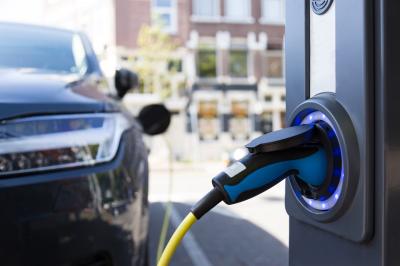Is Erie on Its Way Down to Electric Avenue?
Electric vehicles and supporting infrastructure could use a jolt
In order to achieve net zero emissions by 2050, Earth's dependency on fossil fuels will need to go the way of the dinosaurs.
According to the United Nations Intergovernmental Panel on Climate Change, who set the goal, that's our only hope of limiting the average global temperature to 1.5 degrees Celsius (2.7 degrees Fahrenheit) above pre-industrial levels. The repercussions of climate change are already being felt in the form of droughts, wildfires, flooding, and more severe and more frequent weather events. As average global temperatures rise, so do the human and economic costs.
The transportation sector has been one of the biggest contributors to climate change over time, with the average (internal combustion engine) passenger vehicle emitting approximately 4.6 tons of carbon dioxide annually. Multiply that by the number of vehicles on the road and the numbers become very alarming very quickly. This is why local and national governments the world over, including Pennsylvania, are implementing plans for broadscale adoption of electric vehicles (EVs), which produce little to no emissions.
EVs come in two major categories — battery-electric (vehicle runs off electric battery power exclusively for its entire range) and hybrid (vehicle runs off electric battery power for the first 20-50 miles of its range before switching over to internal combustion). Batteries are replenished at Level 1, Level 2, or Direct Current (DC) charging stations. As the slowest option, Level 1 is only practical for overnight home use. Level 2 is the most prevalent station type, offering 10 to 25 miles of range per hour of charging. Still, that's not exactly suited to long distance or expedited travels, which is why DC charging stations are the future — a half hour's charge with nets 100 to 250 miles of range.
The number of EV registrations in Pa. doubled between 2017 and 2019, demonstrating progress, but there is still a long way to go. In our corner of the state, the distance seems even greater. Per the Pennsylvania Electric Vehicle Roadmap: 2021 Update published by the Pennsylvania Department of Environmental Protection (DEP), there were no more than 15 EVs registered in any zip code within Erie County. Statewide, EVs only constituted about 1.15 percent of light-duty vehicle sales in Q3 2020, the most recent for which data is available.
Driving PA Forward is the state's comprehensive plan to facilitate the transition to clean and alternative fuel sources, both commercially and publicly. It touches on everything from boats to buses, but of most interest to civilian commuters will be the DC Fast Charging and Hydrogen Fueling grant program and the Level 2 EV Charging rebate program. These programs incentivize laying down the infrastructure for a future when EVs are the norm. To that end, the Wolf administration is currently (no pun intended) drafting legislation that would require automakers and brokerages to make EV options more widely available to all Pennslyvanians.
About the DC Fast Charging and Hydrogen Fueling Grant Program
- Grants totaling $10 million over 5 years (program launched 2 years ago)
- Grants award maximum of $250,000 for DC charging stations; up to $500,000 for the much rarer hydrogen fueling stations (hydrogen fuel cells combine stored hydrogen gas with oxygen to generate electricity)
- Awards given to projects strategically located near "destination locations" and "transportation corridors" where pollution is high and greater rates of EV usage are anticipated — as of now this includes the Philadelphia, Pittsburgh, Allentown, Harrisburg, Lancaster, and Scranton/Wilkes-Barre metropolitan areas.
- Nearly $1 million of these grants were recently awarded to four projects in the Philly and Pittsburgh metro areas, which will add a total of 16 DC charging stations near I-76, I-95, I-376, and I-476.
- These four projects collectively will prevent an estimated 771 tons of carbon dioxide, half ton of nitrogen oxides, 0.3 tons of volatile organic compounds, 186 pounds of coarse particulate matter, and pound of fine particulate matter from entering the atmosphere.
- Funding comes from the commonwealth's share of a national settlement with the Volkswagen Group of America, which was cheating EPA emissions tests.
About the Level 2 EV Charging Program
- Over $7.7 million worth of rebates to be rewarded to installers of Level 2 EV charging equipment over a 5-year period
- Rebates for charging equipment for both public and non-public use (i.e. at workplaces and multi-unit dwellings that can be shared between employees or residents, respectively)
- Level 2 Charging stations do have a small presence in Erie — there are currently 14 of them within a roughly 10 mile radius of the city, nine of which are free to use.
When Will Erie Go Electric?
It is difficult to predict when EVs might dominate our streets — for that distinction still belongs to the potholes. Leading EV manufacturer Tesla has still not found an outlet here, but a number of our dealerships offer hybrid or battery-electric models of other makes. The infrastructure is still lacking and does not seem an immediate priority of PennDOT and the DEP — surprising when considering Erie's central location between three major metropolitan areas, but unsurprising when acknowledging the minimal adoption rate of EVs locally.
Nonetheless, a map of PennDOT's planned electric vehicle corridors, which will feature charging stations every 50 miles within 5 miles of a major interstate, reveals Erie County's portions of I-79 and I-90 as "pending." So it seems we are indeed gonna rock down to electric avenue — but we may be waiting in the garage for a while while our ride charges.
Matt Swanseger's first vehicle, an absolutely fierce chili pepper green '02 Mercury Cougar, raged itself to an early grave at a very shameful 15 mpg clip. He'll read your email faster than that thing became scrap metal at mswanseger@eriereader.com


.png)
